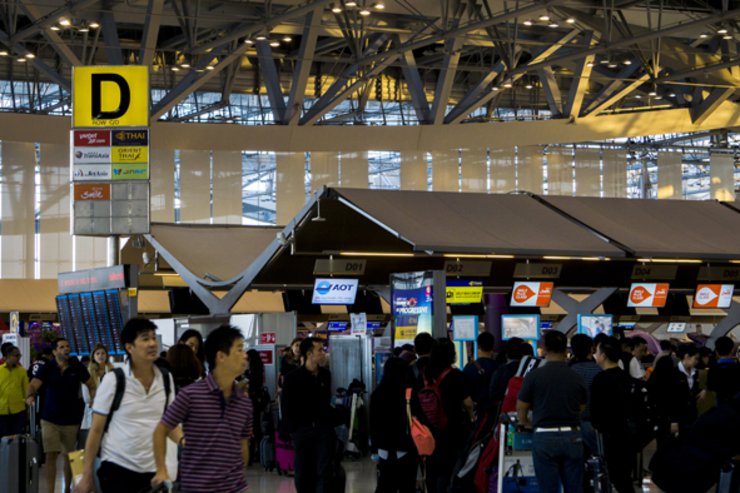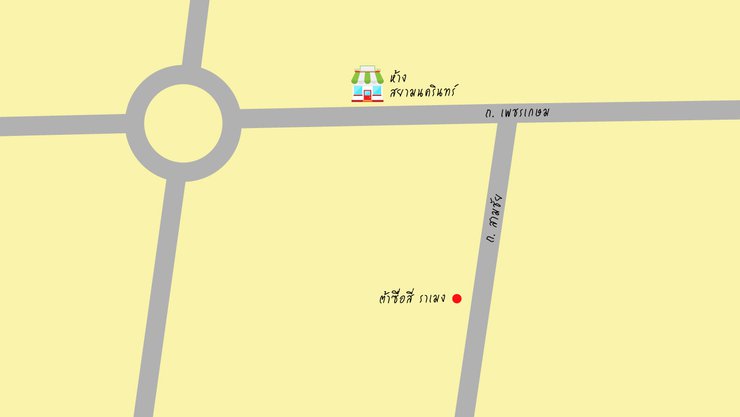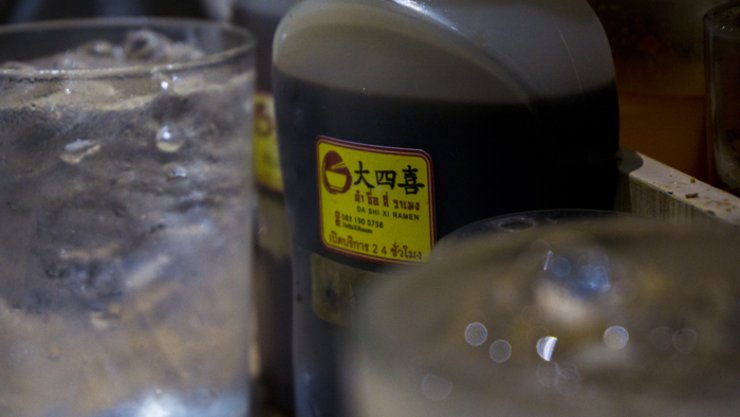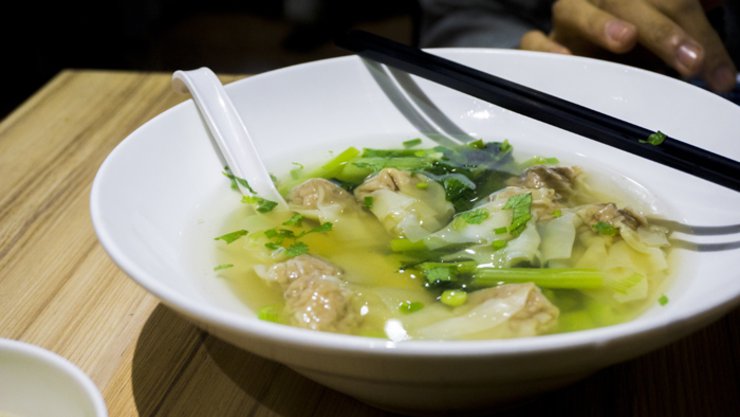As the year draws to a close and winter approaches, the northern and northeastern regions of Thailand experience a cool season. The central region and Bangkok experience occasional cool spells, while the southern region is in the midst of its monsoon season, bringing heavy rainfall. Many people flock to the north to escape the heat, but I prefer to avoid the crowds (although I wouldn't mind meeting some new people, haha!). So, I decided to head south instead.
Please Translate:
The provided text is empty. There is nothing to translate.

There are many ways to get to Hat Yai, including by bus, train, or plane. For this trip, we opted for the affordable and convenient option of flying with Thaismile Airlines, departing from Suvarnabhumi Airport. We enjoyed delicious sandwiches and refreshing orange juice during the flight. Upon arrival in Hat Yai, various transportation options are available, including airport limousines, airport vans, taxis, and blue songthaews (shared taxis) located in front of the airport. Car rentals are also available, although the exact prices are unknown. For this trip, I was fortunate to have a family member pick me up.
***This review provides a rough map for you, which may not be very detailed, but I assure you that you will not get lost because Hat Yai is a small and lovely city that is not complicated.

Upon arrival, hunger pangs set in. Having not visited Hat Yai for a long time, I decided to indulge in some delicious local cuisine. This trip, I opted for something different than the usual dim sum, as I had already enjoyed it frequently. My first stop was Da Si Si Ramen, a restaurant renowned for its Betong-style noodles. Conveniently, it operates 24 hours a day. To reach the restaurant, simply follow Phetkasem Road into the city center. After passing the roundabout, look to your right for Siam Nakhonrin Department Store. The restaurant is located nearby.




If you enjoy eating noodles, you might like this restaurant. The food is delicious and affordable.

No text to translate.
Let's start our trip! Today, we'll be exploring Hat Yai. When people think of Hat Yai, the first thing that comes to mind is the Kim Yong Market. So, let's head there first. To get to Kim Yong Market, if your accommodation is near Phetkasem Road, simply wait for a songthaew (a type of shared taxi). These vehicles have high roofs and come in various colors: blue, red, green, and white. Each color goes to a different destination, but all of them pass by Kim Yong Market. Just make sure you get on the correct side of the road and ask the driver before boarding. Once you reach Kim Yong Market, press the bell to get off. It's easy to spot the market as it's located at a major intersection with the VL Hotel and a bridge leading to Hat Yai Nai.






The Kim Yong Market is a great place to find snacks and souvenirs. If you arrive early in the morning, you can also find a fresh market next to Kim Yong selling various food items. The market itself is quite dark, making it difficult to take clear pictures. However, you can find a variety of imported snacks, primarily from Japan. Previously, most snacks were imported from Malaysia, but now the selection has expanded to include Japanese snacks as well.

Walking from Kim Yong, you will come across the Si Chang intersection. Here you will find the Si Chang Temple. It is easily recognizable as the Chinese temple that appears to be unfinished.





You can enter the temple to pay respects and pray to the Buddha. Although it may seem like the temple is still under construction (as far as I know, the temple lacks funds and budget, and some believe that the temple will never be completed. In fact, since I studied in Hat Yai until I moved to Bangkok, the temple has not been completed). From Wat Chue Chang, walk through the alley next to the temple. You can choose any alley on either side of the temple. I chose Thang Chan Alley. Walk for a while, and you will see a red temple gate at the mouth of the alley. Walk in, and the next temple is Wat Thawararam.





This Chinese temple is another one that becomes very lively during the Vegetarian Festival. It wasn't as big as it is now in the past. Now, you can see it from afar.

I recommend taking a stroll through the central shopping district of Hat Yai. For those who enjoy shopping, I highly recommend Santisuk. If you're looking for reasonably priced products, this is the place to be. Photography is not permitted inside, as it is prohibited.











Alternatively, you can visit Nippat Uthit Road 1-3, locally known as Sai 1, Sai 2, and Sai 3. This area is bustling with shops, restaurants, and even a shopping mall. You can also find Sino-Portuguese buildings, typical of Phuket, although they are somewhat scarce. Moving on, if you're craving food sold on trains, head to Hat Yai Junction, where you can enjoy it without even boarding a train.

Next, let's head to Mahapannawittayalai University. Getting there is very easy (just follow the map).







Today's third Chinese temple, I actually call it Thawaron Temple 2. Here you will also find Chinese monks. The place is huge. They said you can walk up to see the view from the top of the pagoda (but I didn't go up).

From Mahapannawittayalai University, continue to the Phra Maha That Chedi Trai Phum, or the Stainless Steel Chedi, located on a hill. The drive up is not difficult, with no steep inclines or sharp curves. To get there, exit Mahapannawittayalai University and go straight until you reach a three-way intersection. Turn right, then left at the next three-way intersection. Continue straight along the road.

Look for this sign on the left-hand side and turn in. You won't get lost.



The road is in good condition, although it may be a bit narrow. It is safe for driving and can accommodate both cars and motorcycles (I rode my motorcycle alone, which was a bit lonely).

We have arrived at the Triloka Mahathatu Chedi, also known as the Stainless Steel Chedi.

















Please remove your shoes before entering the pagoda. You may enter and climb to the top of the pagoda.



The view outside the pagoda is like this (I didn't think Hat Yai would have such a complex mountain range view).

Let's continue. We will go to the temple on the hill next. At Hat Yai Park, it's easy to get there. After going down the hill, take the exit. When you reach the three-way intersection, turn right and go straight. Look for the Hat Yai Park sign. You won't get lost for sure. Just go straight. The park will be on your right.

Before reaching the park, you will see the Phra Phutthamongkhon Maha Ratcha and the Goddess of Mercy on Khao Kho Hong from afar.






Before climbing the mountain, let's take a walk and enjoy the slow life. Haha! There used to be a zoo here, but now it's gone. There are other activities to replace it, such as a water park where you can play in the water, feed the fish, paddle a boat, paint, or just relax and recharge. (Everyone looks so relaxed.)







Without further ado, let's ride a motorcycle up the mountain. The first stop is "Thao Maha Phrom," which is very popular with tourists, especially Malaysians.


The highlight of Hat Yai Park is taking the cable car to worship the Buddha. If you don't have your own transportation, there is a shuttle bus service from the foot of the mountain to the Phra Phuttha Mongkhon Maha Ratcha statue. Then, you can take the cable car from there to Thao Maha Phrom and ride back down. (I happened to ride my own motorbike and was a bit cheap, so I didn't take the cable car.)



Continue riding to reach Phra Buddha Mongkol Maha Ratcha, the city pillar Buddha statue of Hat Yai. This statue, bestowed with its name by His Majesty King Bhumibol Adulyadej, is the largest Buddha statue in the Southern region of Thailand, depicting the posture of bestowing blessings.



Enjoy the view of Hat Yai. On one side, you can see the city of Hat Yai, and on the other side, you can see Songkhla Lake.







Descending a little further, you will find the Goddess of Mercy. By the time you finish visiting the Goddess of Mercy, it will be the end of the day. I'm so hungry! Let's go find something to eat.






Let's eat at Nai Yao's rice porridge shop. It's a very famous restaurant. The food is good, but it's expensive. (You might ask why I said it's expensive, well, it's really expensive.) I'm not a big eater, so I try to choose restaurants that I think I'll enjoy. Hahahaha. The interesting thing about this restaurant is that they charge prices in the hundreds of thousands. Three hundred, they say, is three hundred thousand. It's their belief that charging high prices will bring them wealth and prosperity. After leaving this restaurant, I passed by another restaurant that looked like a Hong Kong dim sum place, so I decided to stop by.

Just a short walk from Naii Yao Restaurant, you'll find this little dim sum spot.










The food is reasonably priced and good, but unfortunately, the Xiao Long Bao was sold out. The taste is decent, but a bit bland (or maybe I just have a salty palate). It wasn't too greasy, which is good. After finishing my meal, my eyelids are heavy, so I'm going home to sleep. I have a lot to do tomorrow.






Starting a new day with a lot of energy, I went for a walk at Ko Seu Market. There is a wide variety of food available. Watching the locals do their morning shopping, I looked for delicious sticky rice with fried chicken and crispy shallots. Speaking of fried chicken in Hat Yai, tourists often mention a shop called "D-D and C-C." They say it's very famous. I've tried it before, but I didn't think it was that good. I used to love the fried chicken from the cart behind Hat Yai Hospital. The lady would come and sell in the evening, and it was truly amazing. Another shop is near Wat Chue Chang, also a cart. And then there's the one at Ko Seu Market. However, I heard that the fried chicken shop near Kim Yong Market is delicious, but I haven't tried it yet. Oh, the food at Ko Seu Market is very cheap. I used to buy a bag of curry for 20 baht, and it's still 20 baht now (although the quantity has decreased, the price remains the same. You can eat your fill and sleep soundly). If you want to eat southern Thai curry on a budget, come to this market.

Let's continue our journey. Today, we will start from the fountain roundabout. Drive straight along Nipphat Songkhro 1 Road for a long distance until you reach Lop Buri Ramesuan Road. Turn right and continue straight ahead. On your left-hand side, you will see the Songkhla Central Mosque. Stop by and take some photos.


Proceed straight from the mosque until you reach the Ha Yaek Nam Kratai intersection. Continue straight ahead to enter Songkhla city (construction is currently underway, so please check if this route is still accessible). You will pass Thaksin University and reach a three-way intersection. Turn left and look for the Songkhla provincial arch. At the first traffic light, turn right (look for the Hat Kao Seng sign). Continue straight for a short distance and look for the Wat Khao Kao Saen sign. Turn according to the sign.





At Khao Kao Saen Temple,


This is the story of Nang Raeng, a wealthy merchant who heard about the construction of a stupa in Nakhon Si Thammarat. He sailed his ship to participate in the merit-making, but his ship was wrecked in a storm near Songkhla. He repaired his ship at Khao Saeng Beach and learned that the stupa had already been completed. Nang Raeng was heartbroken and fell ill. He buried his treasure worth a hundred thousand at the foot of a cliff and wished for the strength to lift a large rock to cover it. Before he died, he wished that only his descendants or those who wanted to restore the dilapidated stupa could take the treasure. To this day, no one has been able to move the rock from the cliff. (Source: Sanook Travel)



On the other side, there is the sea with a cool breeze. Let's move on. I'm going to Nang Ngam Road to take pictures with Street Art and eat ice cream in a clay pot.











Nang Ngam Road is a historic district in Songkhla. Nowadays, there are street art installations at various points. You can find a map of the street art on Google.










Established in 1914 by Khun Ratchakijchari (Chunliang Limsaowaphak), the "Hap Ho Hin" rice mill was later acquired by his nephew, Mr. Suchart Rattanaprakan, 14 years later. The mill was modernized with steam engines and used rice husk as fuel. The name "Hap Ho Hin" is Hokkien for "unity, harmony, and prosperity." During World War II, the Japanese occupied Songkhla and used the red mill as a medical warehouse. After the war, the rice mill ceased operations and was converted into a rubber warehouse for export and a fishing pier. Today, it houses the Songkhla City Lovers Association. (Source: songkhlacityskru)




A small museum called Baan Nakorn.



Walk to the City Pillar Shrine.

At the city pillar shrine, there is a "Guay Teow Tai Rong Ngio" (noodle shop under the Chinese opera stage), but it was closed. I've never had the chance to try it, as I only recently discovered it. Haha!



You can try the ice cream at Oeng as a consolation. There is another ice cream shop that is also popular, but I was too full to try it.



Leaving the old town, we head to Khao Takiab. We will take a tram to the top of the hill (not free, there is a fee). On the top of Khao Takiab, there are important historical sites, including the Royal Pagoda, the Pavilion of King Rama IV, and the lighthouse. (I thought I had already taken a picture of the pavilion, but when I checked, I forgot! I'm so sorry!)




Departing from Khao Tang Kuan, we headed towards the Naga statue at Suan Song Talay. Along the way, we spotted a sunflower field and decided to stop for some photos. It wasn't a large field, just a small patch planted by the roadside, but it was a charming sight.



We have arrived at another landmark of Songkhla, the Naga spitting water (like the Merlion). It has both a head, a navel, and a tail, but they are in different places.
The two-day, one-night trip ended at the Naga fire-breathing show. See, when you think of Hat Yai and Songkhla, you don't have to think of Hat Yai fried chicken and Kim Yong Market. There are so many places to visit here. This is just a taste of what's available. There are waterfalls, mountains, and fields of sunflowers. Oh, there are so many things to see and do. Next time I have the chance to go home, I'll take you to see some new places.
Follow our travel reviews and discussions at: Fanpage เที่ยวคนเดียวต้องสตรอง
เที่ยวคนเดียวต้องสตรอง
Friday, October 4, 2024 3:10 PM



















